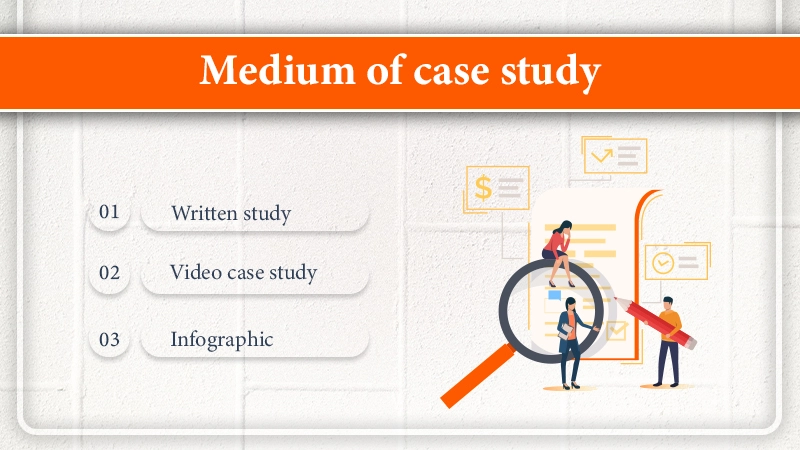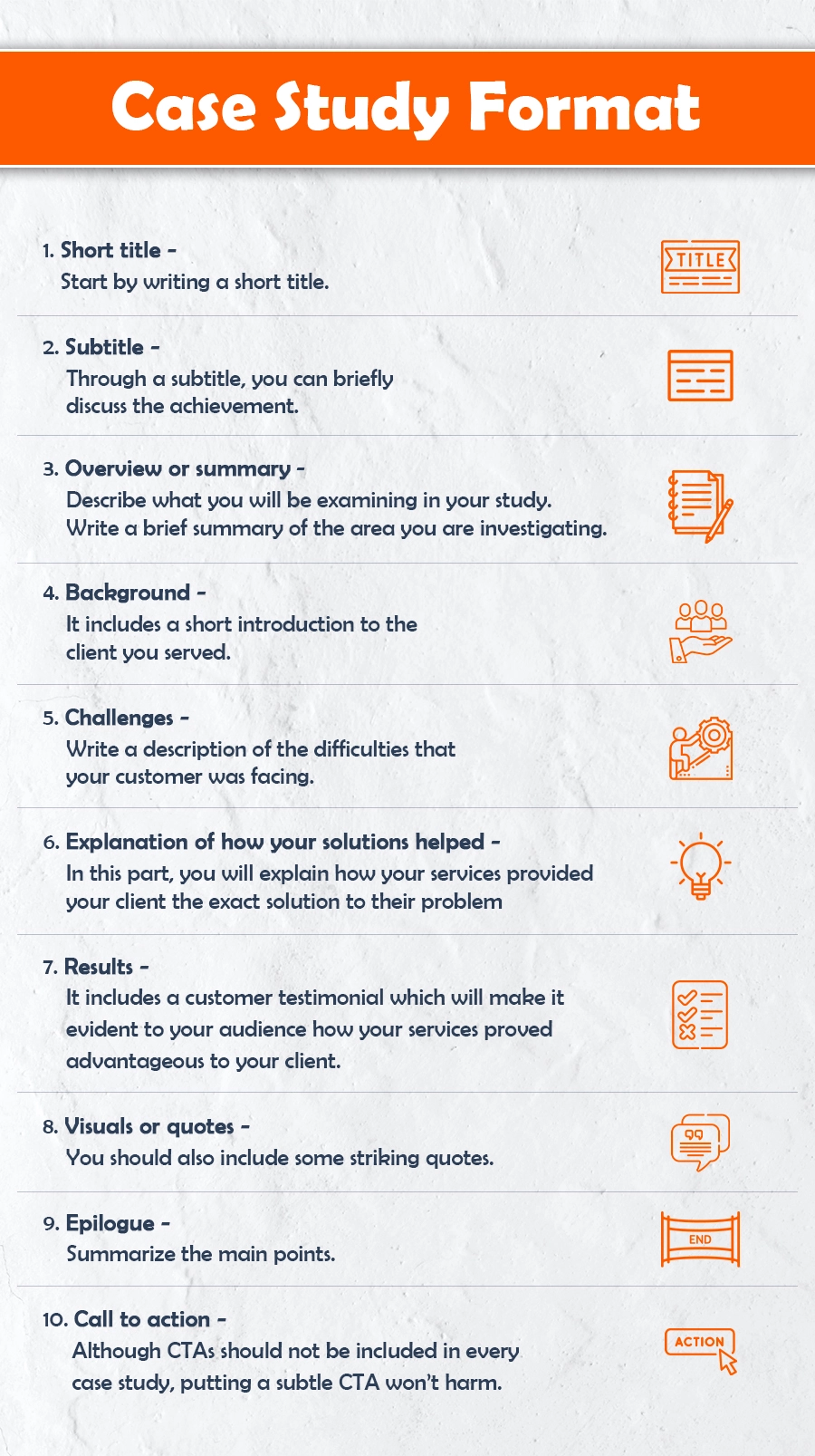Businesses everywhere desire to acquire the trust of their target audience. And why not? When your prospective customers trust your services, only then can they engage further with them. But to earn their trust, you should be able to showcase the evidence of your product’s capacity to meet their needs. The best way to do it is with a case study. But how to write a case study? Compelling case studies are an outcome of much research. To create a great one for your brand, you need to follow a systematic process. In this post, you’ll find out how you can make impressive case studies and boost your business.
How to Write a Case Study – A Stepwise Procedure
A case study outlines a particular challenge that an organization has encountered and what they’ve done to resolve it. In professional settings, case studies usually demonstrate successful business partnerships and how they led to the growth of the business. When prepared properly, case studies serve as examples of business expertise. It helps you attract more customers and increase the loyalty of your existing ones.
Here’s a stepwise process you should follow for writing a case study that will convince your target audience about the effectiveness of your offerings.
1. Find the objective of your case study
Case studies are primarily designed to showcase the value of your products or services. However, they can concentrate on various objectives. Your objective will rely on what exactly you wish to prove about your business to your target customers. So, the first part of case study writing is to finalize the goal of the issue you will be talking about. Put simply; you should be clear about what you have achieved by the end of your study. Here is a list of the different objectives your case study can focus on.
- Government regulation compliance
- Turning more profitable
- Effective lead generation
- Reduction of company expenses
- Increasing the number of customers
- More significant revenue generation
2. Determine the medium of case study creation
The next step is to find the medium in which you will compose the study. Do not feel that this type of content needs to be composed in single plain pages. You are free to use various media to better market the ultimate peace on different platforms. Some case study mediums that you can look into include the following:
- Written study – You can compose your case study as an eBook and provide it as gated downloadable content on your landing page. Thus, it will become a powerful lead generation tool for you.
- Video case study – You can make a video interacting with your client. With a video case study, the audience gets to see a subject talking about their experience. It, in turn, makes the analysis more credible for the viewer.
- Infographic – Infographic is an excellent way to showcase your success story. While making your case study in this medium, you should highlight the significant KPIs with bold text. You can also use charts to emphasize your customer achievements. These things make the case study more relevant and readable.
3. Pick an appropriate candidate for your case study
Writing a case study goes beyond just choosing a customer and writing a story. Some things to see in prospective candidates are as follows.
- Knowledge of your product – Pick a client who has an understanding of your product. Their knowledge will allow them to communicate the value of your offering in the best possible manner.
- Attainment of excellent results – It’s best to choose clients who have experienced positive results from your products. These clients are already enthusiastic about your product because it has given them a desirable outcome. So, they will communicate about your product correctly and comprehensively.
- Those who were using the services of your competitor – Clients who have switched over to your product after using your competitor’s products are well-positioned to talk about your services competently. Moreover, they’ll also be able to highlight the benefits your product offers over that of others.
4. Set yourself up for success by asking appropriate questions
The foundation of a robust case study is the questions that it asks from their customer. Your interview process should have six distinct sections, which comprise specific questions. These parts form the basis of a compelling case study format. They are as follows:
- Start with your client’s business. You can ask them about the length of time they have been in a specific domain and the strength of their staff. You can also ask about the significant aims of their business at that time.
- Next, ask your client about their problems. Let them speak about the challenges which led them to seek your service.
- You can now find how your client decided to try your service. Ask them questions about how they first came to know about your offering. You can also request them to elaborate on the people involved during the selection procedure and the most important criteria they use to assess their options.
- Now you need to understand the manner in which your customer is utilizing your service or product. It will help you describe how your solution works. Ask them about a specific part of your product or service that they rely on the most. You can also ask them about the people who are mainly using the service.
- In the next part, you will describe the way the solution was executed. Keep the attention on the customer’s experience and expectations. Ask them how your solution fulfilled their requirements and how much time it took for your service to get implemented properly.
- End by demonstrating measurable results. Some questions at this point include asking about how the product helped your client. Encourage your client to enumerate in numbers the outcomes they were able to achieve and the productivity they experienced.
5. Develop the case study format
Developing a well-structured format is essential for knowing how to do a case study properly. Now that you’ve collected all the data, it can seem intimidating to organize it meaningfully. Thoughts like how you should begin, what things you should include, and how to structure it can cloud your mind. To navigate all this, you need to create a case study format.
Different case studies follow different formats. Some are pretty visual, while others are more text-based. The structure of a case study consists of ten primary components.
1. Short title – Start by writing a short title. A simple yet exciting name will make your audience curious about what you did with your client.
2. Subtitle – Through a subtitle, you can briefly discuss the achievement.
3. Overview or summary – In this part, you’ll describe what you will be examining in your study. Write a brief summary of the area you are investigating. Here it is essential to write a thesis statement and summarize the outcomes of your observation. It should not be more than two sentences.
4. Background – It includes a short introduction to the client you served. Ensure that you include the most relevant facts of your case study in it.
5. Challenges – Here, you will write a description of the difficulties that your customer was facing before they availed themselves of your service. In this part, you should also write about the objectives of your client and all that they wanted to attain. It should not be more than three paragraphs long.
6. Explanation of how your solutions helped – In this part, you will explain how your services provided your client the exact solution to their problem. Write how your service improved the current condition, along with testable evidence. Keep it not more than three paragraphs long.
7. Results – It includes a customer testimonial which will make it evident to your audience how your services proved advantageous to your client. Ensure that you write three paragraphs about how your product or solution enabled your client to achieve their objectives. The more numbers you include, the better your case study will become.
8. Visuals or quotes – You should also include some striking quotes that will be present at the end part of the sections given above. A visual or quote is an essential part of case study writing, as it directly supports your argument and assertions.
9. Epilogue – Summarize the main points and give a peek into the future plans of your case study subject.
10. Call to action – Although CTAs should not be included in every case study, putting a subtle CTA won’t harm. On the other hand, it’ll motivate the readers to take the desired action after familiarizing themselves with the tasks you have done for your client.
This was a comprehensive case study foramt that you should follow for composing remarkable studies. This systematic structure will ensure that you are presenting all the relevant information clearly and concisely. It will also trigger your readers to explore more about your services.
Tips for Writing a Case Study
Composing a case study is definitely not an easy task. It requires you to possess different skills than what you employ in everyday writing. But don’t allow it to scare you into not writing this piece of content. Follow the tips given below to compose a winning case study.
- Pick your voice carefully – You can write your case study in either the first person or the third person, depending on your brand and the case study content. Both approaches work fine. Most case studies utilize a blend of both of these voices. But when using a mixture of the first and third person, ensure to enhance the third-person parts with quotes directly from the client’s mouth. It’s because a third-person voice can quickly start sounding too narrative.
- Create a relevant and catchy title – The title is undoubtedly a crucial part of your case study. You need to make it as interesting and attention-grabbing as you can. A good tip here is to use strong action verbs and percentages. Note that highly accurate case study titles give better results. That’s why you can see phrases and terms like ‘By 100%’ and ‘Triple yearly revenue’ appearing in many case studies. Numbers enable readers to gauge your achievements precisely.
- Use simple language – Many businesses harbor a wrong assumption about the language they should use in their case study. They think incorporating corporate terms and technical jargon into their analysis will impress the readers. But this is far from the truth. Effectively writing a case study demands you to stick to a simple and lucid language instead of an overly complicated one. It means that you must refrain from putting technical jargon in your studies. It doesn’t showcase your expertise. On the other hand, they only make the readers feel bored. When you use simple language, it makes your case study more approachable and natural. What’s more, it also facilitates non-customers to interact with your case study without feeling intimidated by your language.
- Put more real numbers in your case study – People remember numbers more than anything. Solid facts and figures shock or surprise them. So naturally, to grab the attention of your readers, you should place more numbers to quantify the results your client was able to achieve. Numbers and figures are very powerful and stay in the memory of readers for a long time. So instead of writing phrases like ‘doubled this’ or ‘tripled that,’ use exact numbers to make your study more convincing.
- Keep the case study chronological – Put all the relevant information in your case study. You should know how to do a case study from beginning to end. Use the format given in the previous section to place all the crucial data in this content. It should follow a chronological pattern. The evidence that you include should be fully accurate. It’ll flesh out the whole circumstances revolving around your engagement with the client. It, in turn, will make your readers comprehend the impact your services were able to make more effectively.
- Don’t forget to place your contact information at the end – Many case studies are designed for press distribution. So, they should include your contact details. It will enable other companies or customers to easily get in touch with you if they have any questions regarding your case study. It also makes the information you have put in the study more accessible to others. So, make sure to include your website, phone number, email, social media profiles, and a short bio.
What Makes Case Study Different From a Research Paper
A research paper relies on intensive research and information analysis. It showcases your capacity to document data and offer valuable insights on a specific matter. The most significant aim of a research paper is to demonstrate your views on your investigation.
The research paper turns the attention of the reader to a specific issue. But case studies delve even further. While writing them, you need to focus more on details, issue assessment, and in-depth analysis through different methods. Case studies also require you to exhibit good storytelling skills. You analyze specific cases for a client. So you have to present it in a manner that appeals to your target audience. You should be able to write it in a manner that gives your readers plenty of hands-on information.
Another point of difference between a case study and a research paper is the length of the content. Case studies are not more than 900 words long. But a research paper is way lengthier. The case study structure is quite similar to storytelling. It has a protagonist, which is your client, and the problem they could overcome because of your services. It is not the case with a research paper.
Can You Use a Template for Writing a Case Study
Templates are a great way to go about writing your case study. They also allow you to structure your information in a better manner. The templates easily summarise critical information. You can also use them as visual prompts to enable readers to skim through your content and comprehend the relevant information that they need.
Case study templates also impart more uniformity to the content you are writing. You can also check the word length, important points, and information that you have to incorporate. Thus, they prevent you from missing any crucial point in your case study. Your readers also get to read the complete study and understand it well.
Summing up
Case studies are undoubtedly quite helpful tools. They exert a tremendously positive influence on your content writing strategy. Many businesses get intimidated by the whole task of creating this kind of content. But it’s really not that difficult to write them. This article has explained everything about how to write a case study. Follow the outline and the tips described in this post, and you can start creating great studies from scratch.


